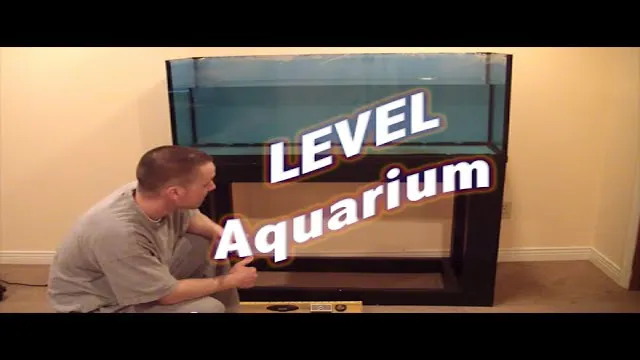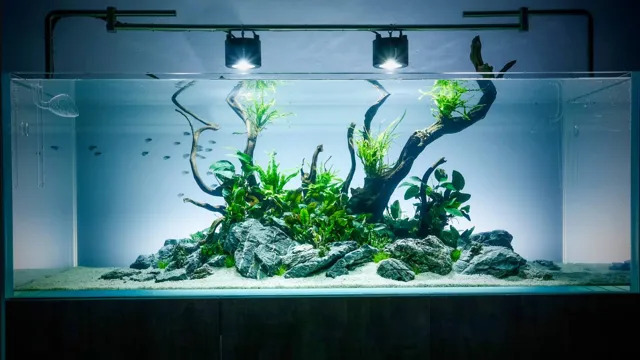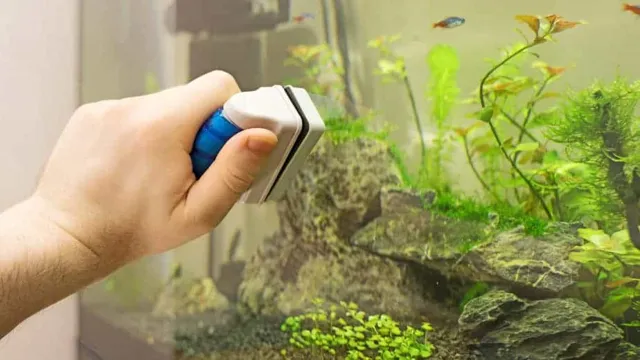Is your aquarium looking a little off-kilter? Do you notice that the water is sloping to one side, making it harder for your fish to swim? Uneven water levels can not only be unsightly but dangerous for your aquatic friends. Luckily, leveling your aquarium is a simple process that any hobbyist can accomplish. In this step-by-step guide, we’ll explain how to level your aquarium, from gathering the necessary tools to implementing the process.
So, grab your level and let’s get started on creating a safe and beautiful underwater world for your fish!
Why Leveling Your Aquarium is Important
If you are setting up a new aquarium or moving an existing one, then leveling it is extremely important. The process of leveling an aquarium involves creating a flat and stable surface for the aquarium to sit on. If the fish tank is not level, then it can create pressure points on the tank’s bottom.
As a result, those pressure points can cause the tank to crack or even shatter, which could lead to fish casualties, water damage, and costly repairs. To level an aquarium, you can use a leveling tool or a simple glass bubble level. Place the level on the surface where the aquarium will be sitting and adjust the tank’s placement until it is level.
Remember that leveling your aquarium is critical for the well-being of your fish and ensuring a long life span for your tank. So, make sure you follow the proper procedures on how to level your aquarium.
Prevent Uneven Pressure on Tank and Potential Cracks
If you’re setting up a new aquarium or just rearranging your current one, it is imperative to ensure that the tank is level. This is not just for aesthetics, but also for the health of your tank and its inhabitants. A tank that is not level can create uneven pressure on the bottom, potentially causing cracks and leaks.
This can be disastrous, as the water could leak out and harm your fish or damage your floors and furniture. Additionally, an uneven tank can also affect the efficiency of any filtration or heating systems in the tank. To avoid these potential problems, take the extra time to level your tank properly before filling it with water.
Use a spirit level to check all sides and adjust as necessary by adding or removing padding under the stand or aquarium. Trust us, the small effort upfront will be worth it in the long run to keep your aquarium healthy and safe.

Maintain Proper Water Level for Filtration and Habitat
Maintaining the proper water level in your aquarium is important for both filtration and providing a suitable habitat for your aquatic pets. If the water level is too low, your filter may not be able to function effectively, causing a buildup of harmful toxins and debris. On the other hand, if the water level is too high, it could cause stress for your fish by reducing the amount of oxygen available and limiting their swimming space.
It is crucial to keep a close eye on the water level and make adjustments as necessary to maintain the ideal level for your specific aquarium setup. Overall, leveling your aquarium is a fundamental aspect of proper aquarium maintenance and providing the best possible living conditions for your aquatic pets.
Preparing Your Aquarium for Leveling
If you’re planning to level your aquarium, you’ll need to prepare your tank beforehand to protect the fish and equipment from damage. First, make sure your aquarium is drained entirely of water and fish. Once the tank is empty, measure the height of the stand legs to ensure they are even and adjust if needed.
Then, you can place a level on top of the stand to check its flatness. If the stand is unlevel, use shims to correct it. It’s important to use waterproof shims that won’t deteriorate with time.
Finally, after the stand is level and secure, you can refill your aquarium with water and return the fish to their home. Overall, leveling your aquarium is an important maintenance task to ensure the stability of your tank and the health of your fish. With these steps, you’ll be able to successfully level your aquarium and maintain a healthy aquatic environment.
Emptying the Tank Completely
Preparing your aquarium for leveling requires you to empty the tank completely. It might seem like a daunting task, but it’s essential for a successful leveling process. Start by unplugging all equipment and taking out any decorations or plants.
Then, carefully remove all the water, using a siphon to get to the bottom of the tank. Be sure to save some of the old water to put back into the tank later. Once the tank is empty, you can start leveling it by placing shims under the low spots.
Make sure to check the level from multiple angles. When you’re satisfied, add the saved water back into the tank. Fill the rest with fresh water and treat it with a water conditioner before adding your fish back in. (See Also: How to Go to Kaiyukan Aquarium from Namba: A Detailed Guide)
Don’t rush the process – take your time and ensure that everything is level before putting your aquatic friends back home. By following these steps, you’ll have a leveled aquarium that’s safe and healthy for your fish.
Cleaning the Tank and Removing Debris
When preparing to level your aquarium, it’s essential to clean the tank and remove any debris. This ensures that the leveling process goes smoothly and that your fish will be living in a clean and healthy environment. To clean your aquarium, start by unplugging all electrical devices and removing any decorations or plants.
Then, use a gravel vacuum to remove any debris on the bottom of the tank. Next, use a scraper to remove any algae buildup on the sides of the tank. Finally, use a sponge or cloth to wipe down the inside and outside of the tank.
Once your tank is clean, you’ll be ready to start the leveling process and give your fish a safe and comfortable home. Remember, keeping your aquarium clean is a continuous process, so make sure to schedule regular cleaning and maintenance to keep your fish happy and healthy.
Choosing an Appropriate Location for Your Tank
Choosing an appropriate location for your tank is crucial in ensuring the longevity of your aquarium. Before you even think about leveling, make sure that you have taken the time to find the perfect spot for your tank. Consider factors such as the weight of the tank and the amount of sunlight and traffic in the room.
Also, think about the type of fish you plan on keeping and the environment they prefer. For example, if you’re planning on having a saltwater tank, you’ll need to make sure that the location is near a power source so that you can operate a protein skimmer. Don’t rush the process of choosing a location – it will save you headaches down the road.
Once you have selected the ideal spot, preparing your aquarium for leveling is critical. A level aquarium distributes weight evenly, reduces stress on the glass, and protects the tank from leaks. Don’t overlook this step – taking the time to level your tank is an investment in your fish’s safety and health.
Leveling Your Aquarium
Leveling your aquarium is crucial for the health and safety of your aquatic pets. An unlevel aquarium can put pressure on the glass or acrylic, leading to stress cracks or even a complete tank failure. To avoid this, start by selecting a level surface or stand for your aquarium to rest on.
Next, place a spirit level on top of the tank and check for any areas that are not level. If necessary, shim the low spots with a waterproof material such as foam or plastic, being careful not to over-correct and create an uneven surface. Once the tank is level, make sure to check it periodically to ensure it remains so.
Remember, taking the time to properly level your aquarium can prevent potentially catastrophic consequences down the line.
Using a Leveling Device to Check for Unevenness
Aquarium leveling device When it comes to setting up your aquarium, having a level surface is crucial for the health and well-being of your fish and plants. Even a slight unevenness in the aquarium stand can lead to stress, discomfort, and potential health issues for your aquatic pets. That’s where using a leveling device comes in handy.
With a leveling device, you can easily detect and correct any unevenness in your aquarium stand, ensuring that your aquarium is level and stable. Using a leveling device is a simple process that involves placing the device on top of your aquarium stand and checking the bubble level. If the bubble is not centered, you can use shims to adjust the level and ensure that your aquarium is stable and safe for your aquatic pets.
So, if you want to keep your fish and plants healthy and happy, don’t forget to use a leveling device when setting up your aquarium.
Adjusting the Tank Base with Shims or Padding
Leveling an aquarium may seem like a daunting task, but it is essential for the health and well-being of your fish and aquatic plants. One of the key components of leveling your aquarium is adjusting the tank base with shims or padding. Shims are thin pieces of wood or plastic that can be placed underneath the tank’s base to level it.
Padding, on the other hand, can be made of foam or cork and provides a softer surface for the tank to rest on. Before adding shims or padding, it is important to make sure that your aquarium stand is also level. Once you have determined the levelness of your stand, simply add the necessary shims or padding underneath the tank until it is level. (See Also: How to Get Rid of Aquarium Snails on Plants: Effective Techniques and Tips)
It is important to check the levelness of the tank regularly as shifting or settling may occur over time. By taking the time to properly level your aquarium, you can ensure the health and longevity of your aquatic inhabitants.
Rechecking the Level and Making Final Adjustments
When it comes to keeping an aquarium, proper leveling is essential. Once you have placed your aquarium on its stand, it’s critical to recheck the level and make final adjustments to ensure that the water doesn’t overflow or put undue pressure on one side of the tank. Using a spirit level, check the level of the aquarium from front to back and side to side.
If it’s off-balance in any way, use shims underneath the stand to re-level it. It’s also important to ensure that the stand is sturdy enough to support the weight of the aquarium. Remember, an unlevelled aquarium can cause leaks, breaks, and other problems down the line, so it’s better to get it right from the get-go.
Filling the Tank and Monitoring for Unevenness
If you’re wondering how to level an aquarium, there are a few things you need to keep in mind. The first step is filling the tank with water until it reaches the appropriate level. It’s important to keep an eye on the water level as you add it, as this will help you ensure that the tank is filled evenly.
Once the tank is full, take a few moments to assess whether it is level. One easy way to do this is to use a spirit level and place it on top of the tank. Check if the level is even across all sides; if it’s not, you’ll need to adjust the tank’s position until it is level.
It’s important to monitor the tank for unevenness over time, as changes in the water level or shifting of the tank can cause it to become unlevel. Making sure your aquarium is level may seem like a small detail, but it can make a big difference in the health of your aquatic pets. So take the time to do it right, and enjoy your beautiful, level aquarium.
Gradually Filling the Tank and Monitoring for Any Shifts
Gradually filling the tank and monitoring for any shifts is a crucial step in ensuring the evenness of your gas distribution system. It’s important to remember to start slowly and add fuel in small increments, allowing time for the fuel to settle in the tank before adding more. This method ensures that the tank distributes fuel evenly, avoiding any unevenness that could cause issues down the line.
Keep a close eye on the fuel gauge and monitor for any sudden changes in the amount of fuel being distributed. If there are any shifts in the tank, it’s important to investigate the cause and address the issue before it grows into a much larger problem. By taking these preventative measures, you can ensure that your gas distribution system remains stable, efficient, and reliable.
Checking Level After Tank is Full and Making Final Adjustments
Once you’ve filled your propane tank to capacity, it’s important to check the level and make any necessary adjustments. Unevenness in the tank can cause air pockets and affect the flow of gas, so it’s essential to ensure that the propane is evenly distributed. A simple way to check the level is to use a leveling tool and make sure the tank is sitting flat on the ground.
If there is any unevenness, you can adjust the placement of the tank or use leveling blocks to even it out. It’s also important to monitor the level periodically, especially during extreme temperature changes, to ensure that the propane is still evenly distributed. By taking these precautions, you can ensure proper functioning of your propane tanks and avoid any potential hazards.
Maintaining Leveling Over Time
Maintaining leveling over time is essential for the health and stability of your aquarium. There are a few simple steps you can take to ensure that your tank remains level. Regularly check the level of your aquarium using a bubble level, and adjust the legs or supports as necessary.
If you notice that your tank is consistently unlevel, consider using shims to help distribute the weight more evenly. Avoid placing heavy objects on one side of the tank, and be sure to evenly distribute decorations and plants. Finally, keep an eye on the flooring underneath your tank, as moisture and weight can cause damage over time.
Overall, with a little bit of attention and diligence, you can easily maintain a level and healthy aquarium for years to come.
Regularly Checking for and Adjusting Any Shifts
Maintaining a level surface is important for any structure and requires periodic inspections and adjustments. Over time, even the sturdiest of foundations can shift due to natural settling, weather conditions, or other structural changes. To ensure your floors, walls, and ceilings remain level, it’s crucial to regularly check for any shifts and make necessary adjustments.
This not only ensures the safety of those occupying the space but also prevents any damage to the structure. Leveling a structure requires specialized equipment and expertise, so it’s best to leave this task to the professionals. A skilled contractor can identify any potential issues and provide effective solutions to maintain a level surface for years to come. (See Also: How to Add Epsom Salt to Aquarium: A Complete Guide for Healthy Fish)
By taking these proactive measures, you can avoid costly repairs and ensure the longevity of your structure.
Replacing or Adjusting Shims or Padding as Necessary
When it comes to maintaining a level surface on furniture over time, replacing or adjusting shims or padding as necessary is crucial. Over time, shims or padding can wear down, compress, or shift, causing the furniture to become uneven. This can be especially problematic for items such as tables or chairs that require a level surface to be functional and safe to use.
When this happens, it’s important to identify any worn or damaged shims or padding and replace them promptly to restore the levelness of the furniture. Just like changing the oil in your car, adjusting shims and padding is an essential part of furniture maintenance that can help extend its life and keep it in good working order. With a little bit of care and attention, it’s easy to keep your furniture level and stable, ensuring that it remains functional and beautiful for years to come.
Conclusion
So, as you can see, leveling an aquarium is not rocket science, but it does require attention to detail and patience. The key is to take your time and follow these simple steps. Remember, a well-leveled aquarium not only looks great but also helps to ensure the health and happiness of your fishy friends.
So, don’t be afraid to get your hands a little wet and put in the effort to level up your aquarium game. Trust me, your fish will thank you!”
FAQs
Why is leveling an aquarium important?
Leveling an aquarium is important because it ensures that the weight of the water is distributed evenly throughout the tank, which helps to prevent stress on the aquarium walls.
What are the steps involved in leveling an aquarium?
The steps involved in leveling an aquarium include finding a level surface, checking the levelness of the surface, placing a level on the tank, adjusting the tank’s feet or adding shims to achieve levelness, and rechecking the levelness.
How do I know if my aquarium is level?
You can check if your aquarium is level by placing a level on top of the tank and seeing if the bubble is centered between the two lines.
Can I use any type of level to level my aquarium?
It is recommended to use a spirit level or bubble level to level an aquarium, as they are more accurate than other types of levels.
What should I do if I cannot level my aquarium?
If you cannot level your aquarium, you may need to consider placing it on a different surface or purchasing leveling equipment, such as shims or adjustable feet.
How often should I check if my aquarium is still level?
It is recommended to check if your aquarium is still level every few months, as changes in temperature or heavy objects placed on the tank can affect its levelness.
Will an unlevel aquarium harm my fish?
An unlevel aquarium can potentially harm fish by putting stress on the tank walls and causing leaks or cracks. It can also cause the water level to be uneven, leading to areas with poor water circulation and oxygen levels.







